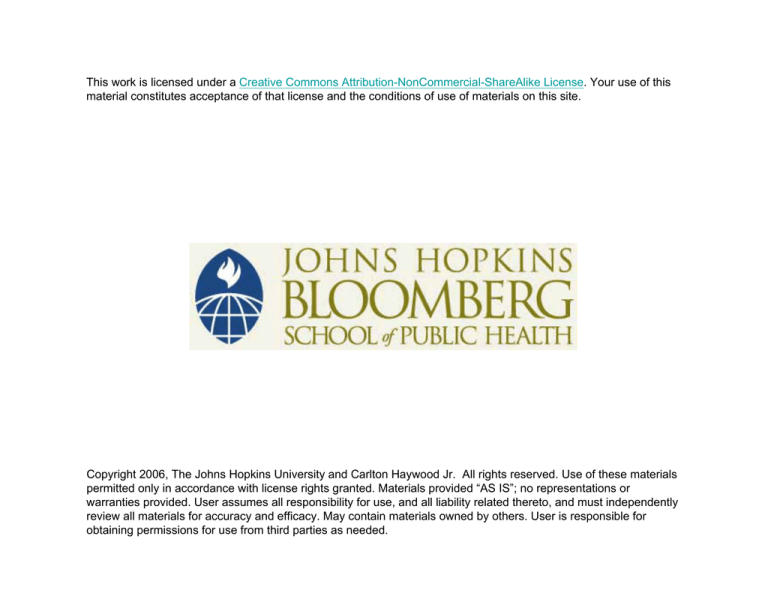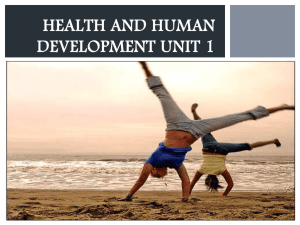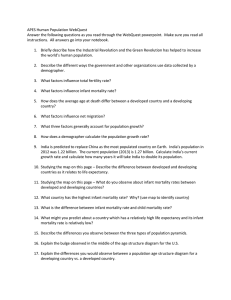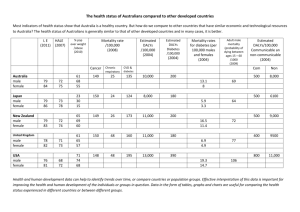
This work is licensed under a Creative Commons Attribution-NonCommercial-ShareAlike License. Your use of this
material constitutes acceptance of that license and the conditions of use of materials on this site.
Copyright 2006, The Johns Hopkins University and Carlton Haywood Jr. All rights reserved. Use of these materials
permitted only in accordance with license rights granted. Materials provided “AS IS”; no representations or
warranties provided. User assumes all responsibility for use, and all liability related thereto, and must independently
review all materials for accuracy and efficacy. May contain materials owned by others. User is responsible for
obtaining permissions for use from third parties as needed.
Ethical Issues in Public Health
Session 7: Priority Setting & the Global Burden of Disease
In the past, mortality figures were the leading concern of policy-makers. However, this
mortality- focused approach has gradually shifted following the development of summary
measures which integrate morbidity, mortality, and disability into one single burden of
disease index (like the DALY).
Approximately 10% of the health research funds from public and private sources
worldwide are devoted to 90% of the global burden of disease (as measured in DALYs).
This is known as the “10/90 gap.” It has been suggested that even this 10% is not used in
the most effective manner.
Approximately 90% of the public sector funds spent on health research are in the hands
of a small number of countries, which have given priority to their own immediate
national health research needs 1 . Private sector funding decisions are based largely on
profit perspectives which inevitably limit investment in diseases prevalent in low and
middle- income countries as market potential in these areas is often thought to be poor
(and arguably underestimated).
Recently, a number of groups have developed recommendations to address this problem.
It has been recognized that greater attention must be given to the process of research
priority setting. Many of the recommendations have focused on the use of summary
measures like the DALY as the primary burden of disease indicator to be used in priority
setting efforts.
Table 1 (page 3) presents 1998 data on the sources of global health research and
development (R & D) funding. Figures 1.1 – 1.3 2 (pages 4-6) and tables 2 – 5 (page s 78) present 2002 data concerning the global burden of disease.
Examine the tables on the following pages and be prepared to discuss the following:
1) Assume, as tables 2 & 3 suggest, that a cost utility analysis (CUA) concludes that
developing effective interventions for heart disease and cerebrovascular disease will be
the most efficient way to reduce mortality globally. After all, these two conditio ns
account for over 20% of total deaths in the world. Note, however, that a global campaign
of this sort would not address the two most important causes of death in high mortality
developing countries. Is this jus t?
2) Now consider tables 4 & 5. Note that the principal causes of disease burden are
somewhat different than the principal causes of mortality alone. Is it more just to plan
global health priorities on mortality disease burden? Here again note that the principal
1
Currat LJ et al. 10/90 Report on Health Research 2003-2004. Global Forum for Health Research. 2004.
Chapter 4, pp. 69. Available: http://www.globalforumhealth.org
2
World Health Organization (WHO). 2004. World Health Report: Annex Table 4 . Available :
http://www.who.int/whr/2004/en/09_annexes_en.pdf Geneva: WHO.
causes of disease burden vary between developed countries and high/low mortality
developing countries.
3) From an ethics stand point, how are we to think about the claims of “funders” to give
priority to the interests and needs of their own stakeholders in setting research agendas?
Address this question both for rich governments and their citizens and private companies
and their stockholders.
Table 1: Estimated Global Health R & D Funding 1998 (in billion current US$) 3
Sources of Financing
Total in billion US$
Per cent of Total
Public: high income and
34.5
47
transition countries
(19.5)
(26.5)
2.5
3
30.5
42
(20.3)
(27.6)
6.0
8.0
(U.S. Share)
(1.9)
(2.6)
TOTAL
73.5
100
(41.7)
(56.7)
(U.S. Share)
Public: low and middle
income countries
Private: pharmaceutical
companies
(U.S. Share)
Private: non-profit funding
(foundations and
universities)
(U.S. Share)
3
Ibid 10/90 Report, Chapter 5, pp. 112.
The World Health Report 2003
countries in Asia, the Eastern Mediterranean Region and Latin America; and 26 years in the
low-mortality developing countries. As shown in Figure 1.1, the large life expectancy gap
between the developed and developing countries in the 1950s has changed to a large gap
between the high-mortality developing countries and others.
Life expectancy at birth in 2002 ranged from 78 years for women in developed countries to
less than 46 years for men in sub-Saharan Africa, a 1.7-fold difference in total life expectancy.
Exceptions to the life expectancy increases in most regions of the world in the last 50 years are
Africa and countries of eastern Europe formerly in the Soviet Union. In the latter case, male
and female life expectancies at birth declined, by 2.9 years and 1 year, respectively, over the
period 1990 to 2000. Estimated life expectancies for males and females for 2002 are given in
Annex Table 1 for all Member States of the World Health Organization (WHO).
The increases in life expectancy that occurred in the first half of the 20th century in developed countries were the result of rapid declines in mortality, particularly infant and maternal
mortality, and that caused by infectious diseases in childhood and early adulthood. Access to
better housing, sanitation and education, a trend to smaller families, growing incomes, and
public health measures such as immunization against infectious diseases all contributed greatly
to this epidemiological transition. In many developed countries, this shift started approximately 100 to 150 years ago. In a number of countries, such as Japan, the transition started
later but proceeded much more quickly. In many developing countries, the transition started
even later and has not yet been completed. In developed countries, improvements in life
expectancy now come mainly from reductions in death rates among adults.
Global mortality patterns
Almost 57 million people died in 2002, 10.5 million (or nearly 20%) of whom were children
of less than 5 years of age (see Figure 1.2). Of these child deaths, 98% occurred in developing
Figure 1.1 Life expectancy at birth: developed and developing countries, 1955–2002
80
70
Life expectancy at birth (years)
4
60
50
40
30
Developed
20
Developing – low mortality
Developing – high mortality
10
0
1940
1960
1980
Year
2000
2020
Note: The term developed countries includes Australia, Canada, European countries, former Soviet countries, Japan, New Zealand and the
USA. High-mortality developing countries include those in sub-Saharan Africa, and countries with high child and adult mortality in Asia,
Central and South America and the Eastern Mediterranean. Other developing countries are referred to as “developing – low mortality”.
Figure 1.2: Health Adjusted Life Expectancy (HALE) by Development Status, 2002
68
67.1
66
Health adjusted life expectancy (years)
64
62
60
58
56.7
56
54
52
50
Developed Countries
Developing Countries
Development Status
Figure 1.3: Health Adjusted Life Expectancy (HALE) by Income Status, 2002
80
71.2
70
Health adjusted life expectancy (years)
61.7
60
50.1
50
40
30
20
10
0
High Income Countries
Low Income Countries
Income Status
Middle Income Countries
Table 2: Ten Leading causes of death, 20024
All Countries
% of Total Deaths
1 Ischaemic heart disease
2 Cerebrovascular disease
3 Lower respiratory infections
4 HIV/AIDS
5 Chronic obstructive pulmonary disease
6 Perinatal conditions
7 Diarrhoeal diseases
8 Tuberculosis
9 Trachea, bronchus, lung cancers
10 Malaria
12.6%
9.6%
6.6%
4.9%
4.8%
4.3%
3.1%
2.8%
2.2%
2.1%
Table 3: Ten Leading causes of deaths for developed and developing countries,
20025
Developed countries
1
2
3
Ischaemic heart disease
Cerebrovascular disease
Trachea, bronchus, lung cancers
4
5
6
7
8
9
10
%
total
deaths
%
total
deaths
22.8%
13.3%
4.5%
1
2
3
Cerebrovascular disease
Ischaemic heart disease
Chronic obstructive pulmonary disease
Lower respiratory infections
Chronic obstructive pulmonary disease
Colon and rectum cancers
Diabetes mellitus
3.3%
3.2%
2.6%
1.8%
4
5
6
7
Lower respiratory infections
Perinatal conditions
Tuberculosis
Stomach cancer
3.7%
3.6%
3.3%
3.1%
Self-inflicted injuries
Hypertensive heart disease
Stomach cancer
1.8%
1.7%
1.7%
8
9
10
Road traffic accidents
Trachea, bronchus, lung cancers
Hypertensive heart disease
3.0%
2.8%
2.7%
Developing high mortality
countries
%
total
deaths
1
2
3
4
Lower respiratory infections
HIV/AIDS
Ischaemic heart disease
Perinatal conditions
5
6
7
Diarrhoeal diseases
Cerebrovascular disease
Malaria
5.5%
5.3%
4.4%
8
9
10
Tuberculosis
Chronic obstructive pulmonary disease
Measles
3.6%
2.8%
2.5%
4
Developing low mortality
countries
10.0%
9.6%
9.3%
6.6%
Mathers CD et al. Global Burden of Disease in 2002: data sources, methods, and results. World Health
Organization. December 2003. Table 10, pp. 47. Available http://www.who.int
5
Ibid, Table 15, pp. 52
13.8%
9.7%
9.5%
Table 4: Ten leading causes of burden of disease and injury, 2002 6
% of total
DALYs
All countries
1
Perinatal conditions
6.5%
2
3
4
Lower respiratory infections
HIV/AIDS
Unipolar depressive disorders
5.8%
5.8%
4.5%
5
6
7
Diarrhoeal diseases
Ischaemic heart disease
Cerebrovascular disease
4.1%
3.9%
3.3%
8 Malaria
9 Road traffic accidents
10 Tuberculosis
3.0%
2.6%
2.4%
Table 5: Leading causes of burden for developed and developing countries, 20027
Developed countries
% total
DALYs
Developing low mortality
countries
% total
DALYs
1
2
3
4
Ischaemic heart disease
Unipolar depressive disorders
Cerebrovascular disease
Alcohol use disorders
9.1%
7.3%
6.4%
3.6%
1
2
3
4
Unipolar depressive disorders
Perinatal conditions
Cerebrovascular disease
Road traffic accidents
6.0%
5.9%
5.0%
3.7%
5
2.8%
5
2.6%
2.5%
6
7
Ischaemic heart disease
Chronic obstructive pulmonary
disease
Lower respiratory infections
3.3%
6
7
Hearing loss, adult onset
Chronic obstructive pulmonary
disease
Road traffic accidents
8
9
10
Trachea, bronchus, lung cancers
Alzheimer and other dementias*
Self-inflicted injuries
2.4%
2.3%
2.3%
8
9
10
Tuberculosis
Diarrhoeal diseases
Cataracts
2.4%
2.4%
2.4%
Developing high mortality
countries
% total
DALYs
1
2
HIV/AIDS
Lower respiratory infections
9.2%
8.5%
3
4
5
Perinatal conditions
Diarrhoeal diseases
Malaria
8.0%
5.8%
5.1%
6
7
8
9
Maternal conditions
Unipolar depressive disorders
Ischaemic heart disease
Measles
3.1%
3.1%
2.9%
2.8%
10
Tuberculosis
2.7%
6
7
Ibid, Table 18, pp. 53-54.
Ibid, Table 20, pp. 57.
3.1%
2.6%






